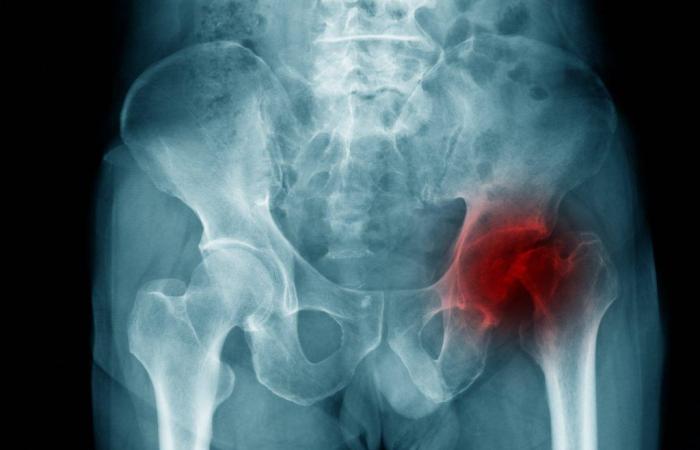Common among the elderly, fracture of the upper end of the femur (FESF) is a source of intense pain. As part of the thesis work for their specialized studies diploma (DES) in emergency medicine, two young doctors intern at the Hyères hospital center, Patrick Calati and Camille Lenoir, studied the interest of a new method to improve pain management. This emerging technique of locoregional anesthesia, the PENG-Block, had never been tested in an Emergency department. Their study demonstrated that this gesture “carried out by emergency physicians trained in the method, is effective in relieving patients and allows a reduction in the use of morphine”.
Dr Laurent Caumon, coordinating doctor of this pilot study, details the objectives and conclusions.
An anatomical discovery
Several reasons led the Hyères team to experiment with the PENG-Block to complement the traditional emergency care for pain in the context of hip fractures. Starting with a fairly recent anatomical discovery: the innervation of the upper end of the femur.
“These are nerve branches which circulate between the pubis and the anterosuperior iliac spine. With PENG-Block, we place, under ultrasound, a local anesthetic product, ropivacaine, where these sensitive branches circulate. , is that with this method, we regulate the pain without blocking mobility The patient is able to leave the block by walking, describes Dr. Caumon. With old techniques, we anesthetized the femoral nerve. It was the only one taken into account for pain management. And that meant average efficiency and an inability to move.”
Preserve mobility
We come to the second reason which led the Hyères team to be interested in PENG-Block.
Hip fracture is very harmful. “In 90% of cases, it concerns people over 60 years old; 20% of them experience complications, 40% suffer a loss of autonomy and for 25%, the fracture leads to institutionalization in an EHPAD, summarizes Dr. Caumon. Worse still, 25% will die within the year. This is a rate equivalent to, or even higher than, that of myocardial infarction at one year!”
Improving pain while preserving mobility is therefore not anecdotal. “Reducing pain from the moment of treatment in the Emergency Department, operating and rehabilitating quickly reduces mortality, the risk of complications and allows better recovery of mobility”, confirms the doctor.
Reduce morphine use
A third objective motivated the study: to make it possible, thanks to the tested method, to limit the use of opiate medications which constitute the classic analgesic treatment for this type of pain, in combination with paracetamol and anti-inflammatories. Once again, this is nothing trivial: “The use of morphine, recalls Dr. Caumon, is associated with cognitive disorders – disorientation, sedation, hallucinations, behavioral disturbances – vomiting and constipation. The repercussions are significant in terms of recovery, especially in elderly patients, potentially with comorbidities.”
Methodology
Concretely, before its implementation, the PENG-Block project required the training of doctors and nurses (ultrasound workshops, carrying out the procedure, skills verification).
Thirty-six patients were included in this randomized study (with a control group receiving only traditional pain treatment) which ended in the first quarter of 2024.
Those who were included in the PENG-Block group benefited from locoregional anesthesia in addition to traditional analgesia upon their arrival in the Emergency Department, even before the x-ray, a very painful step because of the manipulations it involves.
The reduction in morphine consumption was the main criterion for evaluating treatment with or without PENG-Block. The pain felt, tolerance and treatment time were taken into account as secondary criteria.
The results
The results of the study validate the interest of the method. “Morphine consumption decreased significantly in the PENG-Block group, from an average of 0.63 milligrams per hour to 0.24 mg/h,” says Dr. Caumon.
The reduction in pain thanks to the PENG-Block technique was particularly felt in patients who reported extremely intense pain upon arrival in the Emergency Department, compared to those who described it as intense or moderate.
Finally, no side effects were observed and the implementation of PENG-Block did not have a significant impact in terms of extending the support time, whether for access to radio or for the administration of treatment. Many elderly patients are on anticoagulant (four patients in the study) or antiplatelet (three patients) treatment, medications which cause an increased risk of bleeding.
“In these patients, the use of PENG-Block did not give rise to any bleeding complications,” specifies Dr Laurent Caumon.
“The objective now is to promote the use of PENG-Block locoregional anesthesia in Emergency Departments, concludes Dr. Caumon, including for other painful pathologies such as rib, femur or patella fractures, facial or hand wounds.”
Special cases
Many elderly patients are on anticoagulant (four patients in the study) or antiplatelet (three patients) treatment, medications which cause an increased risk of bleeding.
“In these patients, the use of PENG-Block did not give rise to any bleeding complications,” specifies Dr Laurent Caumon.
An orthogeriatrics sector in Hyères
PENG-Block is not the only innovation adopted by Hyères hospital to improve the overall care of elderly fracture patients.
“We have also set up an orthogeriatrics sector, around ten beds where patients are cared for by orthopedic surgeons, geriatricians and physiotherapists for early rehabilitation, which makes it possible to reduce the time of management and improve the quality of care by taking into account all comorbidities.”






